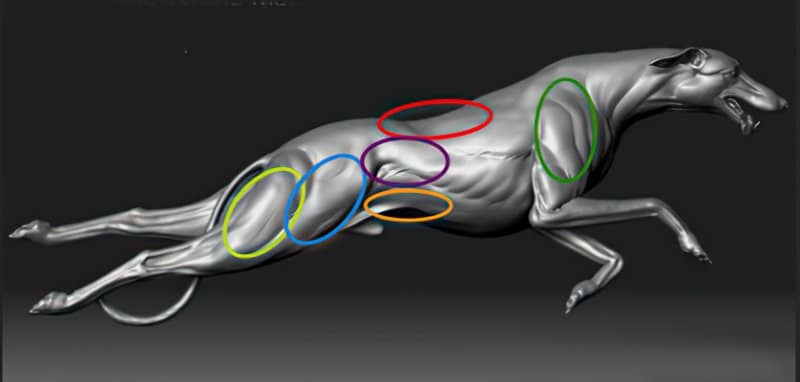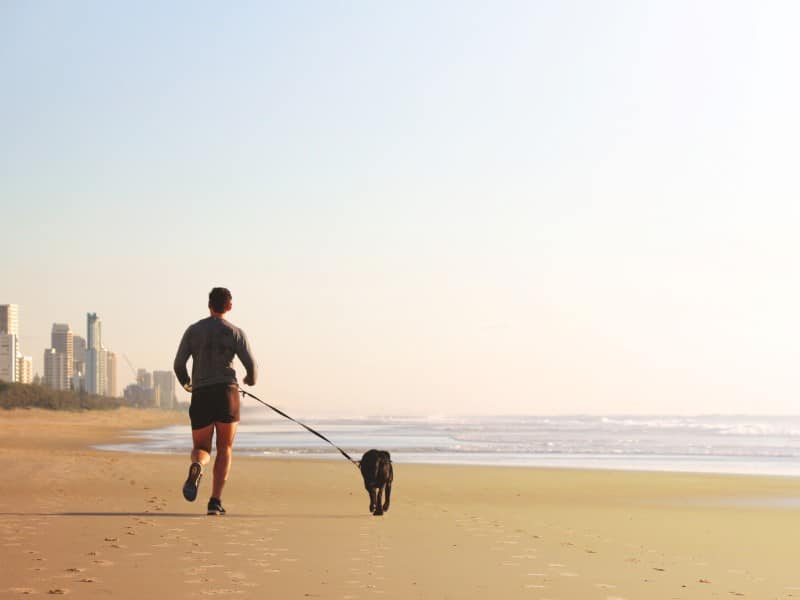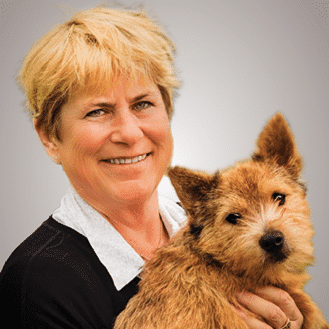Do you want your canine buddy to live a longer, healthier life and avoid expensive injuries? If so, you need a planned exercise program for your dog. It takes only about 10 minutes three times a week. Here’s how to accomplish that.
Evaluate Your Dog’s Fitness
The best way to evaluate your dog’s current condition is to stand your dog in a stacked position as for conformation and feel the size and tone of the six large muscle groups demonstrated by the colors in the attached figure of a well-muscled Greyhound:
1. The large muscles of the front legs surrounding the shoulders and upper arms (dark green)
2. The core muscles, including:
- the paraspinal muscles – those on either side of the spine (red)
- the lateral abdominal muscles (purple)
- the ventral abdominal muscles (orange)
3. The large muscles of the rear legs, including the quads (blue) and the hamstrings (light green)

Of course, you’ve already felt these muscles every time you pet or groom your dog, but now you are going to actually assess them. How big are they? How firm are they? Can you feel the dips where one muscle body joins another? Compare your dog’s muscle size and tone to those of other dogs of the same or different breeds to get a better context as to where each of your dog’s muscles lie on a continuum from small and flabby to huge and body builder-like.
It is ideal for all six muscle groups to feel equally large and firm. Try to determine whether there are imbalances between various muscles. Are the front leg muscles stronger than those of the rear legs? That can indicate a subtle but chronic rear limb or spinal injury. Are the quads stronger than the hamstrings? That imbalance is quite common but also concerning because it increases the risk of cranial cruciate ligament injuries. Are the lateral and ventral abdominal muscles weaker than the paraspinal muscles? Are the core muscles weaker than the muscles of the front or rear legs? Weakness of the core muscles is very common in dogs, just as in humans. The core muscles are essential in coordinating all the complex movements of the spine and the timing of front and rear leg movements, so you’ll want to make sure they are strong enough to do their jobs.
Strength/Resistance Training
Strength exercises for dogs involve movements of the body over short distances. The resistance component can come from the dog’s weight or from tools that resist movement, such as elastic bands (e.g., Therabands) or water. Some of the best strength exercises can be done easily in small spaces and in the air-conditioned comfort of your home, even while you watch television!
Here are the three rules for strength training:
- Exercises should be targeted to strengthen the specific muscles that are weak, such as the core, the front limb, or rear limb muscles.
- The exercises should be as non-impact as possible. For example, an excellent non-impact exercise to strengthen the shoulder muscles is to teach your dog to wave each front paw, holding it higher than the head for as long as possible (up to 30 seconds). An excellent core muscle strengthening exercise is to have your dog beg or sit up on its haunches. You may have heard that this exercise can injure a dog’s back, but studies have shown that just walking up a flight of stairs puts three times greater stress on the back than having your dog sit up.
- To build a muscle’s strength, it must be worked to overload or failure. In other words, the exercise needs to be performed long enough or repeatedly enough so that your dog is unable to continue to perform the exercise properly. In the case of the wave, this would mean that your dog can no longer hold its paw above the head. Or for the sit-up, your dog might have to put its front feet down or it might slump onto one side. When working your dog to overload, be sure to give the muscles some time to rest and repair by not working the same part of the body two days in a row.
The rules for strength training explain why taking your dog for walks on leash, although essential for your dog to experience the joy of the sights, scents, and sounds of nature, is not sufficient to build strength. That is because walks do not target the specific muscles that need work, they are not non-impact, and your dog won’t go into overload before you personally are tired of walking.
Body Awareness Training
Body awareness exercises improve your dog’s ability to know exactly where all the parts of its body are in space. Body awareness is so important that there is an entire segment of the nervous system devoted to that purpose. Like a living GPS system, billions of sensors over the skin and in the muscles and joints send messages to the spinal cord and brain about the positions of various parts of the body. These messages allow your dog to make coordinated movements such as landing from a jump, wrestling with her canine compatriots, or jumping out of your car without tripping or making other potentially dangerous movement mistakes.
As with all nerves, those that govern body awareness can be trained. Just as mastering a musical instrument takes practice, your dog’s body awareness also improves with practice. One of the best and most deceptively simple body awareness exercises is to have your dog walk very slowly through a ladder laid on the ground—using lots of treats, of course! Once your dog can walk forward without touching the edges or the rungs, have it move forward over the length of the ladder, then backward. Next, you can practice with the ladder placed on a hill (facing a different direction each time you train), which increases the challenge. Another variation is to have your dog step sideways with either the front or rear feet in the ladder.
Videos demonstrating dozens of non-impact strength exercises that are targeted to the front legs, rear legs, and core (as well as lots of ideas for body awareness training) can be obtained at: https://caninesports.com/product/ffl-videos/ or https://vimeo.com/ondemand/caninefitforlife.
By incorporating strength and body awareness training to your dog’s care program just two or three times a week, you will be amazed at the changes in your dog’s strength and coordination. You will see more success in conformation as well as in other performance events, fewer injuries, and a longer, healthier life. And who doesn’t want that for their canine companion?










